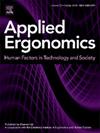Success in goal-directed visual tasks: the benefits of alternating sitting and standing instead of only sitting
IF 3.4
2区 工程技术
Q2 ENGINEERING, INDUSTRIAL
引用次数: 0
Abstract
Both excessive sitting and excessive standing have been shown to be detrimental for performance, productivity and health. In the present study, our objective was specifically to determine the effect of alternating the body position (between standing and sitting) on task performance and visual attention in the Attention Network Task (ANT), relative to a sitting-only condition. Twenty-four participants (aged 18–35) performed the ANT six times in both conditions (5 min 35 per ANT). The proportion of blinks was significantly lower in the alternating condition than in the sitting-only condition. In both between-condition and within-condition analyses, the reaction times were significantly shorter when standing than when sitting. Humans may be more effective (i.e. a shorter reaction time) and have greater visual attention (i.e. less frequent proportion of blinking) in an alternating condition than in a sitting-only condition. In practice, the use of sit-stand desks might usefully help to both reduce the time spent sitting and improve task performance.
成功完成目标导向的视觉任务:交替坐着和站着而不是只坐着的好处
久坐和久站都被证明对工作表现、生产力和健康有害。在本研究中,我们的目标是确定相对于仅坐的情况下,在注意网络任务(ANT)中,交替身体位置(站和坐之间)对任务表现和视觉注意力的影响。24名参与者(18-35岁)在两种情况下进行了6次ANT(每次ANT 5分钟35分钟)。交替状态下眨眼的比例显著低于单纯坐着状态。在条件间和条件内分析中,站立时的反应时间明显短于坐着时。与只坐着的情况相比,人类在交替状态下可能更有效(即反应时间更短),并且有更多的视觉注意力(即眨眼的频率更低)。实际上,使用坐立两用办公桌可能有助于减少坐着的时间,并提高工作表现。
本文章由计算机程序翻译,如有差异,请以英文原文为准。
求助全文
约1分钟内获得全文
求助全文
来源期刊

Applied Ergonomics
工程技术-工程:工业
CiteScore
7.50
自引率
9.40%
发文量
248
审稿时长
53 days
期刊介绍:
Applied Ergonomics is aimed at ergonomists and all those interested in applying ergonomics/human factors in the design, planning and management of technical and social systems at work or leisure. Readership is truly international with subscribers in over 50 countries. Professionals for whom Applied Ergonomics is of interest include: ergonomists, designers, industrial engineers, health and safety specialists, systems engineers, design engineers, organizational psychologists, occupational health specialists and human-computer interaction specialists.
 求助内容:
求助内容: 应助结果提醒方式:
应助结果提醒方式:


